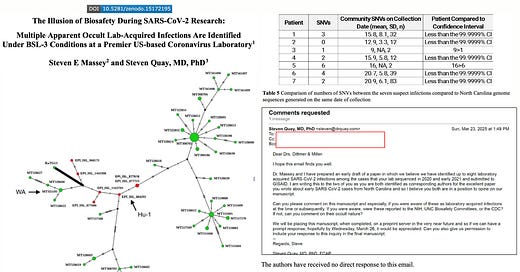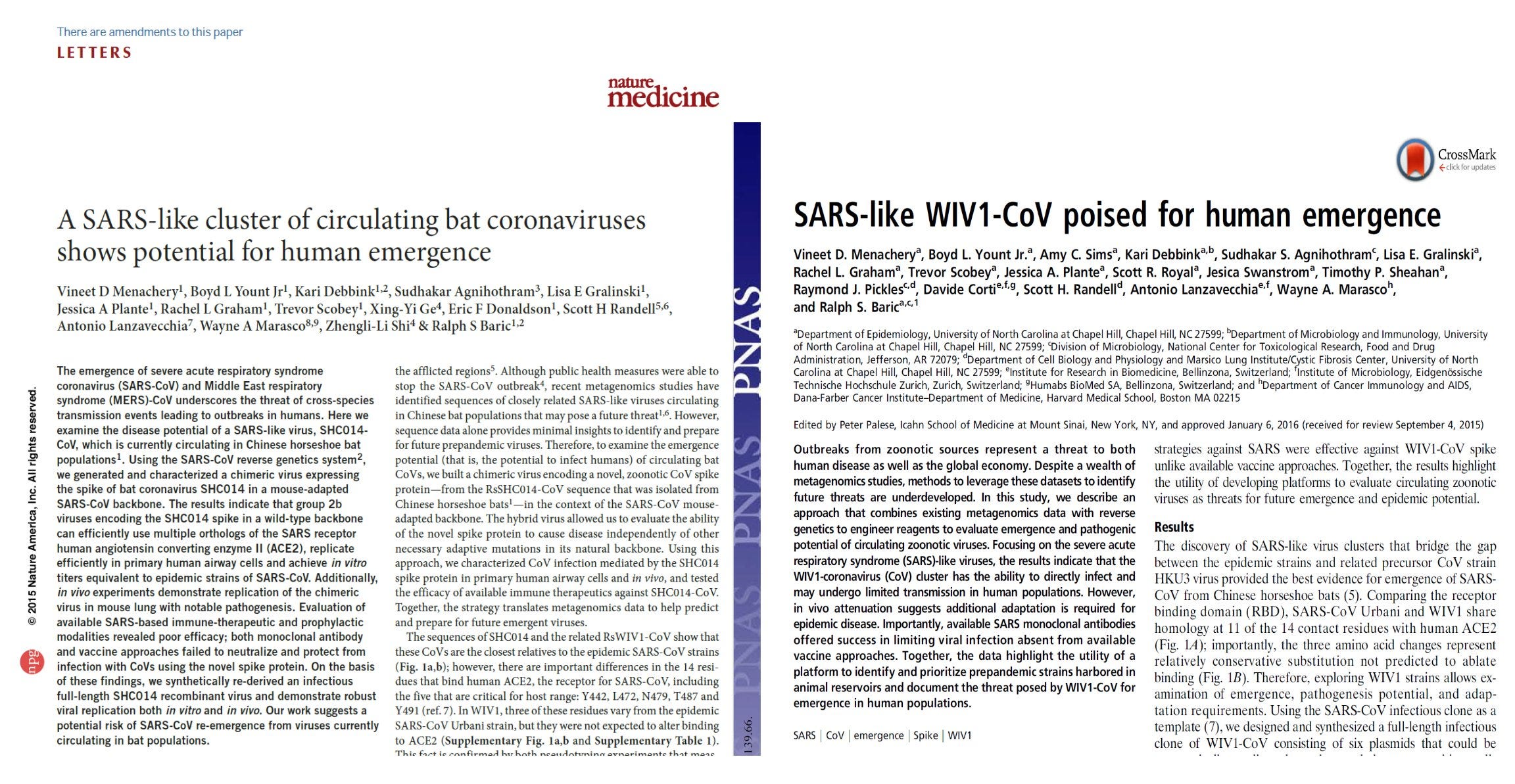BREAKING - Study Finds Multiple SARS-CoV-2 Lab Leaks at UNC Chapel Hill BSL-3 Facility
Ralph Baric’s lab, architect of SARS-CoV-2, implicated in undisclosed lab-acquired infections—new study reveals systemic biosafety failures and suppressed outbreak data.
The study authored by Drs. Steven Massey and Steven Quay titled “The Illusion of Biosafety During SARS-CoV-2 Research: Multiple Apparent Occult Lab-Acquired Infections Are Identified Under BSL-3 Conditions at a Premier US-based Coronavirus Laboratory” was just uploaded to the Zenodo preprint server.
The study identifies seven laboratory-acquired infections (LAIs) with SARS-CoV-2, sequenced from June 2020 to January 2021 at the University of North Carolina (UNC). These infections are suspected to have originated from synthetic virus research conducted under BSL-3 conditions at premier UNC coronavirus laboratories, including the Baric Lab led by the infamous Dr. Ralph Baric. The infected individuals' virus sequences matched early research strains rather than circulating community variants.
The authors noted the following suppression attempts of their research:
Before uploading the first version of this pre-print, the authors contacted the UNC sequencing lab personnel who submitted the suspected LAI cases to GISAID but received no response. Shortly after, the authors were contacted by GISAID's Washington DC office, relaying complaints from unnamed officials at the CDC and UNC about the preprint. GISAID threatened to revoke the authors' access unless metadata and sequence files were removed.
This pressure campaign to suppress inquiry, coupled with a lack of transparency from institutional actors, supports the hypothesis that these infections were potentially acquired in a laboratory setting.
Here are the key points from the study:
Genomic Evidence of Lab Origin
“Frozen” Molecular Clock:
The suspect sequences show significantly fewer mutations (SNVs) than expected based on both global molecular clock estimates and local sequences in North Carolina.
This suggests the viruses had not been replicating in the community but were stored or frozen, consistent with use in laboratory experiments.
Anomalous Phylogeny:
The virus genomes from the 7 patients clustered near the ancestral SARS-CoV-2 node, close to RaTG13, and were basal compared to community sequences.
Phylogenetic trees showed these infections to be genetically out of step with ongoing viral evolution, strongly suggesting they originated from early lab-engineered strains.
Absence of Dominant Mutations:
Most notably, five of the seven sequences lacked the D614G mutation, which had become nearly universal (>99%) in global strains by the time of sample collection.
This makes it statistically implausible that these were natural community infections.
Connection to Specific Lab Research at UNC
UNC’s Baric Lab was actively working on inserting D614G into the WA1 strain to study fitness effects.
Suspected LAIs carried genotypes closely matching:
The WA1 reference strain, used as the basis for many experiments.
Baric Lab’s icSARS-CoV-2-WT and mouse-adapted SARS-CoV-2 clone.
All seven suspect genomes had SNVs previously published or known to be in lab research strains.
Probability & Statistical Analysis
The probability of detecting these rare, ancestral-like strains in the community is astronomically low (e.g., one sequence had a 1-in-296 million chance of appearing naturally).
Comparison of SNV counts in suspect cases to >1800 other sequences from the same time and region shows statistically significant deviation.
Regulatory Failures and Suppression
No lab-acquired infections were reported by UNC, violating biosafety regulations.
Authors received no response from UNC lab personnel upon inquiry.
After uploading the preprint, CDC and UNC officials contacted GISAID (not the authors), demanding changes and threatening revocation of data access.
GISAID required the authors to remove sequence metadata and FASTA files, which the authors replaced with an external DOI link.
This pressure campaign is cited as further evidence of institutional knowledge or concern over potential lab leaks.
Past Biosafety Breaches at UNC
Between 2015–2020, UNC reported 28 lab incidents involving genetically modified organisms, six of which involved SARS/MERS coronaviruses.
Notable incidents include:
A 2016 mouse bite involving synthetic SARS-CoV.
A 2020 mouse bite involving mouse-adapted SARS-CoV-2.
In both cases, post-exposure protocols were inadequate, relying on self-monitoring and inconsistent quarantine practices.
Detailed Case Descriptions of 7 Suspected LAIs
Patients 1–3:
Shared rare sequences closely matching reference or minimally altered lab strains.
Statistically improbable to be found in community settings.
Fit experimental models using WA1 strain with/without D614G.
Patient 4:
Carried an ultra-rare combination of SNVs (C18060T + C22993T) found in no other sequence globally—linked to lab-engineered SARS-CoV-2 clones.
Patients 5–7:
Carried Pango Lineage A with mutations rarely seen in 2021 (0.03% of global sequences in Jan 2021).
Likely represent frozen derivatives of WA1, used in synthetic experiments.
Patient 7 sequence is an intermediate genotype, once dismissed as a sequencing artifact but now reconsidered as real and potentially lab-linked.
Policy Recommendations
Calls for a pause on synthetic pathogen research, particularly gain-of-function, until a robust biosafety system is in place that can detect and report occult LAIs.
Emphasizes that current systems rely on self-reporting, which is insufficient given the potential for institutional cover-ups.
Here it’s important to provide a reminder that there is a mountain of evidence indicating that Ralph Baric and Peter Daszak created SARS-CoV-2:
Why Aren't Daszak and Baric Arrested?
The recent news that Dr. Peter Daszak has been “invited” to a May 1 House of Representatives hearing to question him about his 2018 work on SARS coronaviruses prompted me to review the following email thread dated March 5 - 8, 2018 between Daszak at EcoHealth Alliance, Tonie Rocke at the United States Geological Survey to UNC Professor Ralph Baric.
Ralph Baric and colleagues, funded by the NIH through Peter Daszak and the EcoHealth Alliance, published two papers back in 2015 and 2016 highlighting their creation of chimeric SARS-like viruses at the University of North Carolina at Chapel Hill and the Wuhan Institute of Virology:
It is entirely plausible that some of the earliest U.S. COVID-19 cases—particularly those genetically resembling the WA1 strain or reference constructs—originated from lab-acquired infections at UNC, rather than through international transmission from Wuhan.
High-biosafety level laboratories are clearly not immune to leaks. Gain-of-function research should be banned, and REAL accountability demanded for those who engineered pathogens that spread globally and killed millions of innocent people.
Epidemiologist and Foundation Administrator, McCullough Foundation
www.mcculloughfnd.org
Please consider following both the McCullough Foundation and my personal account on X (formerly Twitter) for further content.








Thank you for your research. It’s never easy finding documentation in years’ past. We must never allow this again. No bird flu nonsense either!
This was NOT A 'LEAK'!!!!!!!!!!!!!!!!!!!!!!
It was a PLANNED RELEASE!
Again, DR. DAVID E. MARTIN has ALL of 'THEIR' DOCUMENTS!!!
For ALL to SEE, if they so CHOOSE!
And 'THEY' started PLANNING this PsyOp, back in the 1990's!!!!